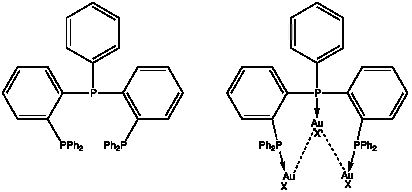 | ||
In chemistry, aurophilicity refers to the tendency of gold complexes to aggregate via formation of weak gold-gold bonds.
The main evidence for aurophilicity is from the crystallographic analysis of Au(I) complexes. The aurophilic bond is assigned a length of about 3.0 Å and a strength of about 7–12 kcal/mol, which is comparable to the strength of a hydrogen bond. The aurophilic interaction is thought to result from electron correlation of the closed-shell components, which is unusual because closed-shell atoms generally have negligible interaction with one another at distances on the scale of the Au-Au bond. This is somewhat similar to van der Waals interactions, but is unusually strong due to relativistic effects. Observations and theory show that, on average, 28% of the binding energy in aurophilic interaction can be attributed to relativistic expansion of the gold d orbitals.
An example of aurophilicity is the propensity of gold centres to aggregate. While both intra- and inter-molecular aurophilic interactions have been observed, only intramolecular aggregation has been observed at such nucleation sites.
Role in self-assembly
The similarity in strength between hydrogen bonding and aurophilic interaction has proven to be a convenient tool in the field of polymer chemistry. Much research has been conducted on self-assembling supermolecular structures, both those that aggregate by aurophilicity alone and those that contain both aurophilic and hydrogen-bonding interactions. An important and exploitable property of aurophilic interactions relevant to their supermolecular chemistry is that while both inter- and intramolecular interactions are possible, intermolecular aurophilic linkages are comparatively weak and easily broken by solvation; most complexes that exhibit intramolecular aurophilic interactions retain such moieties in solution.
Similar metallophilic interactions exist for other heavy metals, such as mercury and palladium, and can also be observed between atoms of different elements. Examples include Pd(II)-Pd(I),Pt(II)-Pd(I), Hg(II)-Au(I), Hg(II)-Pt(II), and Hg(II)-Pd(II). In accordance with theoretical calculations, which predict a local maximum for relevant relativistic effects for gold atoms, none of these other interactions are as strong as aurophilicity. Although metallophilic interactions are not inherently relativistic in their nature, they are complemented by it.
